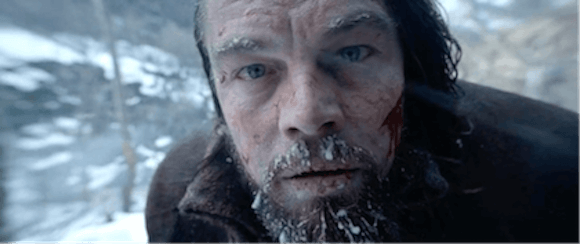March 25, 2016
http://thelacanianreviews.com/lacanian_review_online250316.html

I saw The Revenant after returning to New York City from the desert. Although I was there without devices for only a week, back on the grid I was thrown by the ubiquity of and addiction to the lathouses. The cinema provided no escape. Before Alejandro González Iñárritu’s tale of survival in the American wilderness of 1823 began, policy-trailers reminded the audience to turn off or silence cell phones. But not everyone did, which was a nuisance and caused an argument. Following the chaos and carnage of the spectacular opening scenes, the nearly three-hour film unfolds through untamed and formidable landscapes [1].
Re-acclimating to the alethosphere, I was cognizant of the absence on the big screen of what was elsewhere omnipresent, the small screens. While the films outward and popular appeal [2] may include escapism, to a previous world, without gadgets [3], a veiled one is enduring life today with them, the rapacity and persistence of their demands. With the object now at the social apex, it is the lathouses in absentia that makes The Revenant relevant, and betrays the true signification of “survival” on which the film is marketed [4].
For what is depicted so vehemently in The Revenant is the drive, in its brute or lawless dimension. Leonardo DiCaprio’s visceral portrayal of the frontiersman Hugh Glass reverberates less with the elements and injuries he must bear than with the vagaries of the drive, which are distilled in the isolation and harshness of his odyssey. The push-to-jouir is manifested in his flesh and gives his body moteriality. Bleeding, slavering, crying, or healing, his body “speaks”. The multi-valence of voices in the film – stifled, whispered, subtitled, or disembodied – foregrounds the inescapability of the invocatory drive. “The impact of the voices heard sets up the mystery of the collision between the body and the voice” [5].
Iñárritu draws equal attention to the gaze when, to relay dramatic tension, he places the camera in macro-proximity to DiCaprio’s body. In these instances of heightened physical duress, of surplus, the actor’s breath clouds the camera lens, and hence the image. An alteration in this series is what deciphers the final cut of the film. Near death, after exacting retribution for the murder of his son, Glass looks directly at the proximate camera. His breathing is amplified, not fogged as before. Without it to smoke the screen, I am instantaneously spotted, caught watching in the dark. “If I am anything in the picture, it is always in the form of the screen, which I earlier called the stain, the spot” [6], or as cannily evoked by The Revenant, vapor.
By confronting DiCaprio to the camera that has hunted him throughout the film, Iñárritu insinuates the vanishing of the character into the real of the drive, and betrays the lathouse as a false object, making promises it cannot keep. There is a “selfie” I cannot take.
1. Using only natural light, the film was shot on a large-format Arri Alexa 65 digital camera in Argentina, British Columbia and Montana.
2. The film won three of the twelve Academy Awards it was nominated for, Director, Actor, and Cinematography. Iñárritu won the Directors Guild of America’s Outstanding Directorial Achievement in a Feature Film Award. It received BAFTA awards for Best Picture, Director, and Actor, and won three Golden Globe Awards. As of March 20th, it has grossed $483.2 million US dollars worldwide.
3. The nascent capitalism of the fur trapping trade and its later alliance with science, and the global ecological disasters it hastens, shadows the films pristine scenery.
4. Tag lines include: “Blood Lost. Life Found”; and the pull quote, ”I ain’t afraid of dyin’ no more, I done it already”.
5. Chamizo, Marisa. “Drive and Speaking Body” in The Speaking Body: On the Unconscious in the 21st Century, Scilicet, NLS Publication, 2015. Pg. 99
5. Lacan, Jacques. (1964). The Four Fundamental Concepts of Psychoanalysis, Book XI, W.W. Norton Company. Ed., Jacques-Alain Miller, W.W. Norton and Company, New York/London, 1981. Pg. 97.
Robert Buck © 2016
Download
.png)


